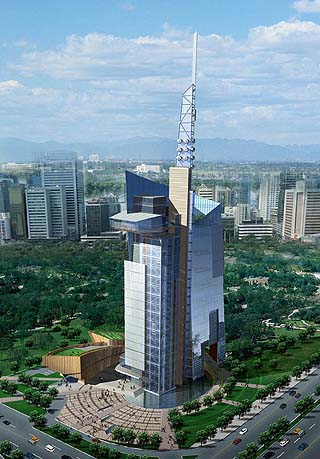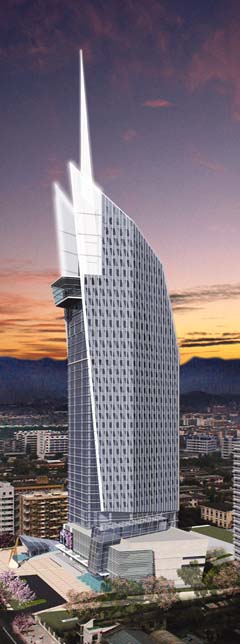
Surveys
DJC.COM
November 18, 2004
Opportunities abound in China for A/E firms
MulvannyG2

Zhang
|
China's thriving economy has meant more than the occasional headache for the United States. The emerging country's voracious appetite for the world's supplies of concrete and steel has funneled the key building materials away from U.S. cities, slowing and even postponing commercial development in some regions.
But China's gain doesn't have to mean our loss. China's success can be a great opportunity for American architects and engineers willing to invest the time, money and energy into forming overseas partnerships.
Bouncing back
China's flourishing economy survived Asia's financial crisis of the late 1990s. Soaring growth coupled with increasing financial solvency are resulting in an unprecedented amount of new construction, especially in the country's more populated cities such as Beijing and Shanghai.
China's consumption of steel stood at 260 million tons last year, accounting for one-third of the world's total, according to an article on Chinadaily.com.

Renderings courtesy MulvannyG2
The design of Shanghai Shidong Power Co.'s proposed headquarters fits China's new taste for cutting-edge architecture.
|
China's entry into the World Trade Organization in December 2001 reduced certain tariffs and trade barriers, opening doors for international business. Beijing was awarded the 2008 Olympics, spurring a building frenzy to prepare the city for worldwide visitors, and Shanghai is preparing to host the World Expo in 2010.
China's nationwide optimism and seemingly insatiable thirst for all things Western result in many opportunities for Americans.
Lucrative for Washington
Due to its proximity to China, Washington state is in a unique position to take advantage of the growing Chinese economy. In recent years, China surpassed Japan as the Port of Seattle's largest trading partner by all measures — tonnage, container volume and dollar value. The Port of Tacoma lists China as top in container volume, and just behind Japan in dollar value.
Gov. Gary Locke has hosted several overseas trade missions to the country, bringing along representatives from Washington businesses such as MulvannyG2 Architecture and Starbucks.
The trips have resulted in millions of dollars in opportunities. MulvannyG2, for example, has designed several projects throughout China, including a pair of hotels, a technology park, a retail center, several high-rises for Chinese utility companies, and has completed the design of a master plan for the Shunyi District, preparing the Beijing suburb for Olympics-related events and growth.
Elaborate designs
China's comeback is anything but routine. The days of boring, boxy buildings are gone — replaced with energetic and creative new structures that push the limits of design in terms of aesthetics, technology and function. Skyscrapers are the norm, featuring flamboyant facades and flashy architectural details.

No more boring boxes in China: Fujian Provincial Electric and Power Co.'s planned office building in Fuzhou sports dramatic fins.
|
The public sector's competition-style architect selection process encourages such designs. These competitions — in which architects present a proposal and detailed concept drawings to a panel of judges organized by the owner — spur extreme creativity rarely seen in the United States.
The new 32-story building for the Fujian Provincial Electric and Power Co. in Fuzhou, for example, features a glass façade, dramatic "fins" and a 22-story communications tower. The 19-story headquarters building for the Shanghai Shidong Power Co. contrasts a circular courtyard base with an angular structure covered in a multi-faceted façade. A spire-shaped communications tower atop the building is illuminated at night.
The designs reflect the Chinese desire for something special and cutting-edge, and with a healthy economy that allows for such experimentation, structures that push the envelope are becoming the norm.
Getting involved
American design firms hoping to benefit from China's growth need to do more than hop on the first flight to Beijing. The Chinese place a high value on relationships, and U.S. companies that have some sort of connection to China will find it easier to do business there.
Hiring native Chinese architects or partnering with established architecture firms in China will boost an American firm's reputation and greatly improve its chances of involvement with a project overseas.
Gaining an understanding of the Chinese way of doing business is an important step for any U.S. design firm. Politics often play a large role in the selection of a design team, especially in the public arena; slowing down the process and cutting into the project's schedule. A jury may take several months deciding on an architect, while other key design and construction benchmarks remain unchanged.
Once a decision is made, however, the project schedule is greatly accelerated. The design team may have only three or four months to finalize schematic designs and complete design development, compared to an eight- to 10-month time frame for a comparable project in the United States.
Because these competitions frequently involve a high degree of design effort and elaborate presentations, they can be costly. Although firms are partially compensated for their efforts, the process can put a financial strain on a company. Consequently, larger, more established firms that can absorb the high costs and manpower required for these intense competitions tend to be more successful.
Also, Chinese law requires native architectural firms to take over the design at the construction document phase, which often leads to issues of quality control. Understanding such differences between the two cultures will help eliminate frustration and disappointment with the process.
Finally, firms interested in ongoing professional involvement in China would be wise to make a firm commitment to working in the country. Some U.S. firms have opened offices in China, underscoring their dedication to remain a long-term contributor to China's future growth.
Like any astute businessperson, the Chinese recognize fair-weather opportunists who are eager to work overseas until business improves back in the U.S. Planting roots demonstrates a dedication that the Chinese appreciate, and conveys the message that your company is serious about doing business in China.
More growth ahead
China's phenomenal rate of growth, thriving economy and upcoming global events seem to indicate continued success for the country of 1.2 billion. The economy is expected to grow by 9 percent this year, according to a study detailed on Chinadaily.com, and industry sources predict expansion of 8.1 percent in 2005.
These indicators, coupled with China's enthusiasm and desire for innovative and creative development, point to continuing opportunities for American involvement in China for years to come.
Ming Zhang is the executive vice president in charge of design at Bellevue-based MulvannyG2 Architecture.
Other Stories:
- A new Rx for emergency room design
- Preparing the next design pioneers
- A new tool for analyzing seismic hazards
- Don't sacrifice green design to 'value engineering'
- How buildings can help 'reforest' a city
- What owners need to know about seismic design
- Unique design brings Boeing workers together
- Ready to go national with your design firm?
- A/E firms look to plastic for growth
- Skinner Building gets a seismic skeleton
- Waterlogged walls? New system will tell you
- Designers — beware of technology convergence
- A past blast: building the road to St. Helens
- Commissioning squeezes the best out of buildings
- Peering into the future of urban supermarkets
- Designers have lofty aspirations for housing
Copyright ©2009 Seattle Daily Journal and DJC.COM.
Comments? Questions? Contact us.